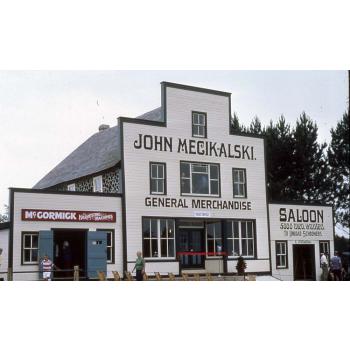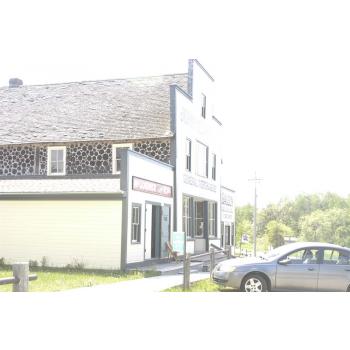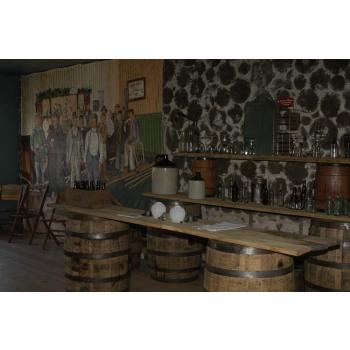Mecikalski Stovewood Building
John Mecikalski emigrated from Prussia with his parents in the mid 1870s. After living in Milwaukee and Shawano County near Green Bay, he got married and bought 160 acres of land in the Schoepke Township of Oneida County in northern Wisconsin. John promoted and developed the land and, along with his brothers, constructed a general store, saloons, a pool hall, grocery, hay barn, sawmill, ice house and candy store. In their unique stovewood building, John Mecikalski and his family combined living quarters, a general store, a grain sales store and an implement store with a saloon and boarding house for local lumberjacks. Ernest, John’s brother, built a store and saloon of his own next door. All members of the Mecikalski family had a specific area of the family business to maintain, and their entrepreneurial drive helped forge a new and profitable logging community during the heyday of the logging industry in northern Wisconsin.
In the 1920s John sold his property to another brother, Henry, who closed the general store and converted the main room into a pool hall and saloon. A decade later, Henry once again converted the building, this time into a farmer’s co-op cheese factory. To bring the building up to state health standards, windows were modified to accommodate milk delivery and concrete flooring was added to the east half of the main store area. The cheese factory operation continued until around 1940 under several owners and operators.
In 1940, the building was purchased by Alex Palubicki, a single man, who used the rear wing for his living quarters and the remainder of the building as storage space. During the following decade, the building began to fall into disrepair and was abandoned in the 1950s. But thanks to a significant contribution by Clara Mecikalski Kulinski, a Town of Schoepke native, the building’s importance resurfaced through an extensive Jennings and Mecikalski family history she researched and wrote in 1955.
Continuing research by Donna M. Gager, under the direction of Professor William H. Tishler of the University of Wisconsin – Madison Department of Landscape Architecture, earned the Mecikalski General Store, Saloon and Boarding House a listing on the National Register of Historic Places in 1984. That same year, Kohler Foundation began restoration of the Mecikalski buildings. After completion, Kohler Foundation gifted the historic site to the Town of Schoepke in a public ceremony on June 20, 1987. A friends group helps support the group and provides tours and programming through the Mecikalski Stovewood Foundation.
The Mecikalski Stovewood Building was deemed to be of national significance because of its cultural importance to Wisconsin and because its stovewood architecture represents a singular American form of folk tradition found primarily in frontier settlements of German and Polish immigrants. There is no conclusive evidence that the craft was first practiced by these ethnic groups in Europe.
What is stovewood architecture? Also referred to as “cord wood,” “wood block,” and “stackwall” architecture, stovewood architecture is characterized by short-cut logs stacked and joined by mortar or clay. In the Mecikalski Stovewood Building, eighteen-inch lengths of cedar logs are laid in a bed of wet lime mortar. The finished wall resembles a stacked woodpile, unlike more conventional long-cut timber structures in which the logs are set to run the length of the wall.
The advantage here is that while traditional log-cabin type structures required long, straight logs, the economical and practical stovewood construction made use of irregular, short lengths -- often leftovers from cut logs or otherwise undesirable wood. Stovewood construction was thus considered appropriate for barns and outbuildings -- over sixty stovewood structures dot Wisconsin’s countryside.
What makes the Mecikalski Stovewood Building unique and worthy of landmark status is its vast size, coupled with the multiplicity of commercial and personal uses. The Mecikalski Stovewood Building stands as a proud tribute to the spirit of Wisconsin’s creative and industrious pioneers.
The site is open seasonally, Saturday and Sunday from 1:00 pm to 4:00 pm.
The 2013 season opens June 8 and closes September 1.





